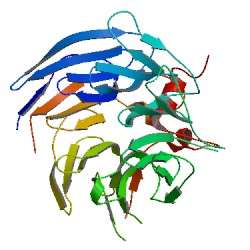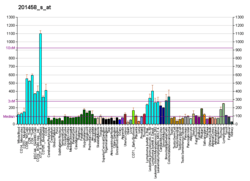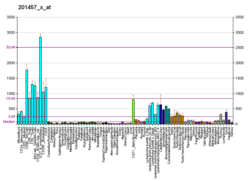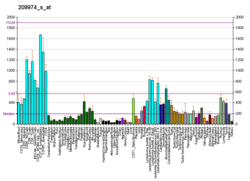BUB3
Mitotic checkpoint protein BUB3 is a protein that in humans is encoded by the BUB3 gene.[5][6]
Bub3 is a protein involved with the regulation of the Spindle Assembly Checkpoint (SAC); though BUB3 is non-essential in yeast, it is essential in higher eukaryotes. As one of the checkpoint proteins, Bub3 delays the irreversible onset of anaphase through direction of kinetochore localization during prometaphase[5] to achieve biorentation. In directing the kinetochore-microtubule interaction, this ensures the proper (and consequenctly, bioriented) attachment of the chromosomes prior to anaphase. Bub3 and its related proteins that form the Spindle Assembly Checkpoint (SAC) inhibit the action of the Anaphase Promoting Complex (APC), preventing early anaphase entry and mitotic exit; this serves as a mechanism for the fidelity of chromosomal segregation.[7]
Function
Bub3 is a crucial component in the formation of the mitotic spindle assembly complex, which forms a complex with other important proteins.[8] For correct segregation of the cells it is necessary for all mitotic spindles to attach correctly to the kinetochore of each chromosome. This is controlled by the mitotic spindle checkpoint complex which operates as a feedback-response.[8] If there is a signal of a defect in the attachment, mitosis will be stopped to ensure that all chromosomes have an amphitelic binding to spindles. After the error is corrected, the cell will proceed to anaphase. The complex of proteins which regulate the cell arrest are BUB1, BUB2, BUB3 (this protein), Mad1, Mad2, Mad3 and MPS1.[8]
Role in the spindle assembly checkpoint
At unattached kinetochores, a complex consisting of BubR1, Bub3, and Cdc20 interact with the Mad2-Cdc20 complex to inhibit the APC, thus inhibiting the formation of active APCCdc20.[9][10] Bub3 binds constitutively to BubR1; in this arrangement, Bub3 acts as a key component of the SAC in the formation of an inhibitory complex.[11] Securin and cyclin B are also stabilized before the anaphase transition by the unattached kinetochores.[12] The stabilization of cyclin and securin prevent the degradation that would lead to the irreversible and fast separation of the sister chromatids.
The formation of these “inhibitory complexes” and steps feed into a ‘wait’ signal before activation of separase; at the stage prior to anaphase, securin inhibits the activity of separase and maintains the cohesion complex.[7]
Structure
The crystal structure of Bub3 indicates a protein of the seven-bladed beta-propeller structure with the presence of WD40 repeats, with each blade formed by four anti-parallel beta sheet strands that have been organized around a tapered channel. Mutation data suggest several important surfaces of interaction for the formation of the SAC, particularly the conserved tryptophans (in blades 1 and 3) and the conserved VAVE sequences in blade 5.
Rae1 (an mRNA export factor), another member of the WD40 protein family, shows high sequence conservation with that of Bub3. Both bind to Gle2p-binding-sequence (GLEBS) motifs; while Bub3 specifically binds Mad3 and Bub1, Rae1 has more promiscuous binding as it binds both the nuclear pore complex and Bub1. This indicates a similarity in interaction of Bub3 and Rae1 with Bub1.[13]
Interactions
BUB3 has been shown to interact with BUB1B,[5][14][15] HDAC1[16] and Histone deacetylase 2.[16]
Bub3 has been shown to form complexes with Mad1-Bub1 and with Cdc20 (the interaction of which does not require intact kinetochores). Additionally, it has been shown to bind Mad2 and Mad3.[11][17]
Bub3 directs the localization of Bub1 at the kinetochore in order to activate the SAC.[5] In both Saccharomyces cerevisiae and metazoans, Bub3 has been show to bind BubR1 and Bub1.[7]
The components that are essential for the spindle assembly checkpoint in yeast have been determined to be Bub1, Bub3, Mad1, Mad2, Mad3, and the increasingly important Mps1 (a protein kinase).
Regulation
When the SAC is activated, the production of the Bub3-Cdc20 complex is activated. After kinetochore attachment is complete, the spindle checkpoint complexes (including the BubR1-Bub3) experience a decrease in concentration.[18][19]
Bub3 also acts as a regulator in that it affects binding of Mad3 to Mad2.[11]
Structural and sequence analysis indicated the existence of three conserved regions that are referred to as WD40 repeats. Mutation of one of these motifs has indicated an impaired ability of Bub3 to interact with Mad2, Mad3, and Cdc20. The structural data suggested that Bub3 acts as a platform that mediates the interaction of SAC protein complexes.[11][13]
Clinical significance
BUB3 forms a complex with BUB1 (BUB1/BUB3 complex) to inhibit the anaphase-promoting complex or cyclosome (APC/C) as soon as the spindle-assembly checkpoint is activated. BUB3 also phosphorylates:
- CDC20 (activator) and thereby inhibits the ubiquitin ligase activity of APC/C.
- MAD1L1, which usually interacts with BUB1 and BUBR1, and in turn the BUB1/BUB3 complex interacts with MAD1L1.
Another function of BUB3 is to promote correct kinetochore-microtubule (K-MT) attachments when the spindle-assembly checkpoint is active. It plays a role in the localization of kinetochore of BUB1.
BUB3 serves in oocyte meiosis as the regulator of chromosome segregation.
Defects in BUB3 in the cell cycle can contribute to the following diseases:[8]
- hepatocellular carcinoma
- gastric cancer
- breast cancer
- cervical cancer
- adenomatous polyposis
- osteosarcoma familial breast cancer
- glioblastoma cervicitis
- lung cancer carcinoma
- Coli polyposis
References
- 1 2 3 GRCh38: Ensembl release 89: ENSG00000154473 - Ensembl, May 2017
- 1 2 3 GRCm38: Ensembl release 89: ENSMUSG00000066979 - Ensembl, May 2017
- ↑ "Human PubMed Reference:".
- ↑ "Mouse PubMed Reference:".
- 1 2 3 4 Taylor SS, Ha E, McKeon F (Aug 1998). "The human homologue of Bub3 is required for kinetochore localization of Bub1 and a Mad3/Bub1-related protein kinase". J Cell Biol. 142 (1): 1–11. doi:10.1083/jcb.142.1.1. PMC 2133037. PMID 9660858.
- ↑ "Entrez Gene: BUB3 BUB3 budding uninhibited by benzimidazoles 3 homolog (yeast)".
- 1 2 3 Morgan, David O (2007). The cell cycle: principles of control. London: Published by New Science Press in association with Oxford University Press. ISBN 0-87893-508-8.
- 1 2 3 4 Kalitsis P, Earle E, Fowler KJ, Choo KH (September 2000). "Bub3 gene disruption in mice reveals essential mitotic spindle checkpoint function during early embryogenesis". Genes Dev. 14 (18): 2277–82. doi:10.1101/gad.827500. PMC 316933. PMID 10995385.
- ↑
- Eytan, E.; Braunstein, I.; Ganoth, D.; et al. (2008). "Two different mitotic checkpoint inhibitors of the anaphase-promoting complex/cyclosome antagonize the action of the activator Cdc20". Proc Natl Acad Sci USA. 105 (7): 9181–9185. doi:10.1073/pnas.0804069105. PMC 2453698. PMID 18591651.
- ↑
- Fang G, Yu H & Kirschner MW (1998). "Direct binding of CDC20 protein family members activates the anaphase-promoting complex in mitosis and G1". Mol Cell. 2 (2): 163–171. doi:10.1016/S1097-2765(00)80126-4. PMID 9734353.
- 1 2 3 4
- Fraschini, R.; Beretta, A.; Sironi, L.; Musacchio, A.; et al. (2001). "Bub3 interaction with Mad2, Mad3 and Cdc20 is mediated by WD40 repeats and does not require intact kinetochores". The EMBO Journal. 20 (23): 6648–6659. doi:10.1093/emboj/20.23.6648. PMC 125326. PMID 11726501.
- ↑
- Li, M.; Li, S.; Yuan, J.; Wang, Z-B; Sun, S-C; et al. (2009). Jin, Dong-Yan, ed. "Bub3 Is a Spindle Assembly Checkpoint Protein Regulating Chromosome Segregation during Mouse Oocyte Meiosis". PLoS ONE. 4 (11): e7701. doi:10.1371/journal.pone.0007701. PMC 2765619. PMID 19888327.
- 1 2
- Larsen, N.A.; Harrison, S.C. (2004). "Crystal structure of the spindle assembly checkpoint protein Bub3". J Mol Biol. 344 (4): 885–92. doi:10.1016/j.jmb.2004.09.094. PMID 15544799.
- ↑
- Sudakin, V; Chan G K, Yen T J (2001). "Checkpoint inhibition of the APC/C in HeLa cells is mediated by a complex of BUBR1, BUB3, CDC20, and MAD2". J. Cell Biol. 154 (5): 925–36. doi:10.1083/jcb.200102093. PMC 2196190. PMID 11535616.
- ↑
- Cayrol, C.; Cougoule, C.; Wright, M. (2002). "The beta2-adaptin clathrin adaptor interacts with the mitotic checkpoint kinase BubR1". Biochem. Biophys. Res. Commun. 298 (5): 720–30. doi:10.1016/S0006-291X(02)02522-6. PMID 12419313.
- 1 2
- Yoon, Y-M; Baek, K-H; Jeong, S-J; et al. (2004). "WD repeat-containing mitotic checkpoint proteins act as transcriptional repressors during interphase". FEBS Lett. 575 (1–3): 23–9. doi:10.1016/j.febslet.2004.07.089. PMID 15388328.
- ↑
- Logarinho, E.; Bousbaa, H. (2008). "Kinetochore-microtubule interactions "in check" by Bub1, Bub3 and BubR1: The dual task of attaching and signalling". Cell Cycle. 7 (12): 1763–1768. doi:10.4161/cc.7.12.6180. PMID 18594200.
- ↑
- Yu, H. (2002). "Regulation of APC–Cdc20 by the spindle checkpoint". Current Opinion in Cell Biology. 14 (6): 706–714. doi:10.1016/S0955-0674(02)00382-4. PMID 12473343.
- ↑
- Doncic, A.; Ben-Jacob, E.; Einav, S.; Barkai, N. (2009). Khanin, Raya, ed. "Reverse Engineering of the Spindle Assembly Checkpoint". PLoS ONE. 4 (8): e6495. doi:10.1371/journal.pone.0006495. PMC 2714964. PMID 19652707.
External links
- Human BUB3 genome location and BUB3 gene details page in the UCSC Genome Browser.
Further reading
- Cahill DP, da Costa LT, Carson-Walter EB, et al. (1999). "Characterization of MAD2B and other mitotic spindle checkpoint genes". Genomics. 58 (2): 181–7. doi:10.1006/geno.1999.5831. PMID 10366450.
- Kwon TK, Hawkins AL, Griffin CA, Gabrielson E (2000). "Assignment of BUB3 to human chromosome band 10q26 by in situ hybridization". Cytogenet. Cell Genet. 88 (3–4): 202–3. doi:10.1159/000015547. PMID 10828586.
- Saffery R, Irvine DV, Griffiths B, et al. (2001). "Components of the human spindle checkpoint control mechanism localize specifically to the active centromere on dicentric chromosomes". Hum. Genet. 107 (4): 376–84. doi:10.1007/s004390000386. PMID 11129339.
- Kaplan KB, Burds AA, Swedlow JR, et al. (2001). "A role for the Adenomatous Polyposis Coli protein in chromosome segregation". Nat. Cell Biol. 3 (4): 429–32. doi:10.1038/35070123. PMID 11283619.
- Sudakin V, Chan GK, Yen TJ (2001). "Checkpoint inhibition of the APC/C in HeLa cells is mediated by a complex of BUBR1, BUB3, CDC20, and MAD2". J. Cell Biol. 154 (5): 925–36. doi:10.1083/jcb.200102093. PMC 2196190. PMID 11535616.
- Saxena A, Saffery R, Wong LH, et al. (2002). "Centromere proteins Cenpa, Cenpb, and Bub3 interact with poly(ADP-ribose) polymerase-1 protein and are poly(ADP-ribosyl)ated". J. Biol. Chem. 277 (30): 26921–6. doi:10.1074/jbc.M200620200. PMID 12011073.
- Saxena A, Wong LH, Kalitsis P, et al. (2003). "Poly(ADP-ribose) polymerase 2 localizes to mammalian active centromeres and interacts with PARP-1, Cenpa, Cenpb and Bub3, but not Cenpc". Hum. Mol. Genet. 11 (19): 2319–29. doi:10.1093/hmg/11.19.2319. PMID 12217960.
- Baek WK, Park JW, Lim JH, et al. (2003). "Molecular cloning and characterization of the human budding uninhibited by benomyl (BUB3) promoter". Gene. 295 (1): 117–23. doi:10.1016/S0378-1119(02)00827-2. PMID 12242018.
- Strausberg RL, Feingold EA, Grouse LH, et al. (2003). "Generation and initial analysis of more than 15,000 full-length human and mouse cDNA sequences". Proc. Natl. Acad. Sci. U.S.A. 99 (26): 16899–903. doi:10.1073/pnas.242603899. PMC 139241. PMID 12477932.
- Liu L, Amy V, Liu G, McKeehan WL (2003). "Novel complex integrating mitochondria and the microtubular cytoskeleton with chromosome remodeling and tumor suppressor RASSF1 deduced by in silico homology analysis, interaction cloning in yeast, and colocalization in cultured cells". In Vitro Cell. Dev. Biol. Anim. 38 (10): 582–94. doi:10.1290/1543-706X(2002)38<582:NCIMAT>2.0.CO;2. PMC 3225227. PMID 12762840.
- Beausoleil SA, Jedrychowski M, Schwartz D, et al. (2004). "Large-scale characterization of HeLa cell nuclear phosphoproteins". Proc. Natl. Acad. Sci. U.S.A. 101 (33): 12130–5. doi:10.1073/pnas.0404720101. PMC 514446. PMID 15302935.
- Yoon YM, Baek KH, Jeong SJ, et al. (2004). "WD repeat-containing mitotic checkpoint proteins act as transcriptional repressors during interphase". FEBS Lett. 575 (1–3): 23–9. doi:10.1016/j.febslet.2004.07.089. PMID 15388328.
- Gerhard DS, Wagner L, Feingold EA, et al. (2004). "The status, quality, and expansion of the NIH full-length cDNA project: the Mammalian Gene Collection (MGC)". Genome Res. 14 (10B): 2121–7. doi:10.1101/gr.2596504. PMC 528928. PMID 15489334.
- Tang Z, Shu H, Oncel D, et al. (2004). "Phosphorylation of Cdc20 by Bub1 provides a catalytic mechanism for APC/C inhibition by the spindle checkpoint". Mol. Cell. 16 (3): 387–97. doi:10.1016/j.molcel.2004.09.031. PMID 15525512.
- Andersen JS, Lam YW, Leung AK, et al. (2005). "Nucleolar proteome dynamics". Nature. 433 (7021): 77–83. doi:10.1038/nature03207. PMID 15635413.
- Mendoza S, David H, Gaylord GM, Miller CW (2005). "Allelic loss at 10q26 in osteosarcoma in the region of the BUB3 and FGFR2 genes". Cancer Genet. Cytogenet. 158 (2): 142–7. doi:10.1016/j.cancergencyto.2004.08.035. PMID 15796961.
- Rual JF, Venkatesan K, Hao T, et al. (2005). "Towards a proteome-scale map of the human protein-protein interaction network". Nature. 437 (7062): 1173–8. doi:10.1038/nature04209. PMID 16189514.
- Lo KW, Kogoy JM, Pfister KK (2007). "The DYNLT3 light chain directly links cytoplasmic dynein to a spindle checkpoint protein, Bub3". J. Biol. Chem. 282 (15): 11205–12. doi:10.1074/jbc.M611279200. PMID 17289665.







